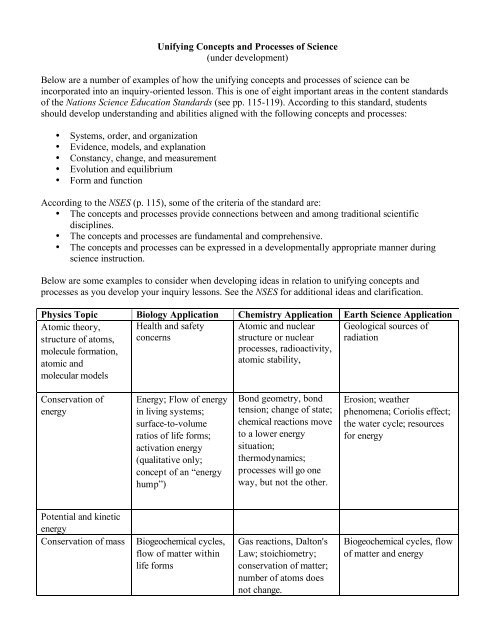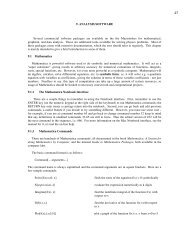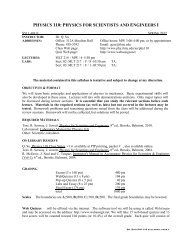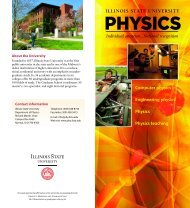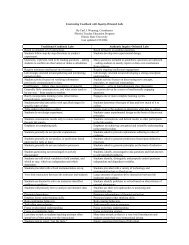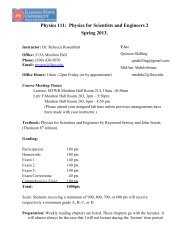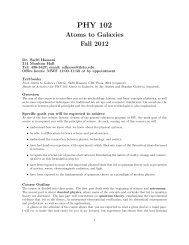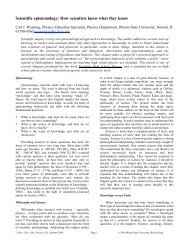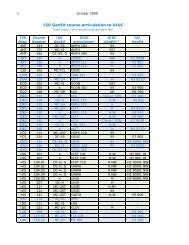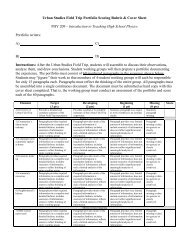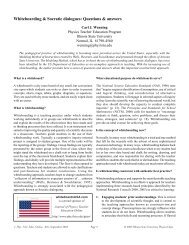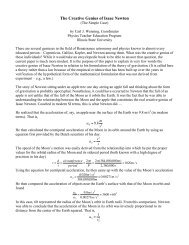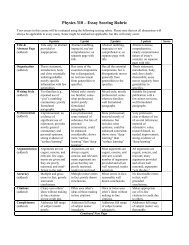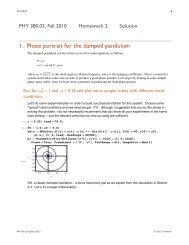Unifying Concepts and Processes of Science (under development ...
Unifying Concepts and Processes of Science (under development ...
Unifying Concepts and Processes of Science (under development ...
Create successful ePaper yourself
Turn your PDF publications into a flip-book with our unique Google optimized e-Paper software.
<strong>Unifying</strong> <strong>Concepts</strong> <strong>and</strong> <strong>Processes</strong> <strong>of</strong> <strong>Science</strong><br />
(<strong>under</strong> <strong>development</strong>)<br />
Below are a number <strong>of</strong> examples <strong>of</strong> how the unifying concepts <strong>and</strong> processes <strong>of</strong> science can be<br />
incorporated into an inquiry-oriented lesson. This is one <strong>of</strong> eight important areas in the content st<strong>and</strong>ards<br />
<strong>of</strong> the Nations <strong>Science</strong> Education St<strong>and</strong>ards (see pp. 115-119). According to this st<strong>and</strong>ard, students<br />
should develop <strong>under</strong>st<strong>and</strong>ing <strong>and</strong> abilities aligned with the following concepts <strong>and</strong> processes:<br />
• Systems, order, <strong>and</strong> organization<br />
• Evidence, models, <strong>and</strong> explanation<br />
• Constancy, change, <strong>and</strong> measurement<br />
• Evolution <strong>and</strong> equilibrium<br />
• Form <strong>and</strong> function<br />
According to the NSES (p. 115), some <strong>of</strong> the criteria <strong>of</strong> the st<strong>and</strong>ard are:<br />
• The concepts <strong>and</strong> processes provide connections between <strong>and</strong> among traditional scientific<br />
disciplines.<br />
• The concepts <strong>and</strong> processes are fundamental <strong>and</strong> comprehensive.<br />
• The concepts <strong>and</strong> processes can be expressed in a <strong>development</strong>ally appropriate manner during<br />
science instruction.<br />
Below are some examples to consider when developing ideas in relation to unifying concepts <strong>and</strong><br />
processes as you develop your inquiry lessons. See the NSES for additional ideas <strong>and</strong> clarification.<br />
Physics Topic Biology Application Chemistry Application Earth <strong>Science</strong> Application<br />
Atomic theory,<br />
structure <strong>of</strong> atoms,<br />
Health <strong>and</strong> safety<br />
concerns<br />
Atomic <strong>and</strong> nuclear<br />
structure or nuclear<br />
Geological sources <strong>of</strong><br />
radiation<br />
molecule formation,<br />
processes, radioactivity,<br />
atomic <strong>and</strong><br />
atomic stability,<br />
molecular models<br />
Conservation <strong>of</strong><br />
energy<br />
Energy; Flow <strong>of</strong> energy<br />
in living systems;<br />
surface-to-volume<br />
ratios <strong>of</strong> life forms;<br />
activation energy<br />
(qualitative only;<br />
concept <strong>of</strong> an “energy<br />
hump”)<br />
Bond geometry, bond<br />
tension; change <strong>of</strong> state;<br />
chemical reactions move<br />
to a lower energy<br />
situation;<br />
thermodynamics;<br />
processes will go one<br />
way, but not the other.<br />
Erosion; weather<br />
phenomena; Coriolis effect;<br />
the water cycle; resources<br />
for energy<br />
Potential <strong>and</strong> kinetic<br />
energy<br />
Conservation <strong>of</strong> mass<br />
Biogeochemical cycles,<br />
flow <strong>of</strong> matter within<br />
life forms<br />
Gas reactions, Dalton's<br />
Law; stoichiometry;<br />
conservation <strong>of</strong> matter;<br />
number <strong>of</strong> atoms does<br />
not change.<br />
Biogeochemical cycles, flow<br />
<strong>of</strong> matter <strong>and</strong> energy
Electricity/Charge;<br />
electrical energy <strong>and</strong><br />
power<br />
The human body as an<br />
electrical system<br />
Chemical reactivity <strong>and</strong><br />
relationship to structure;<br />
simple chemical<br />
bonding; electronegativity<br />
used to<br />
describe bonding<br />
Lightning<br />
Energy as a universal<br />
currency<br />
Gases <strong>and</strong> laws <strong>of</strong><br />
thermodynamics<br />
Energy use by living<br />
systems<br />
Exothermic or<br />
endothermic reactions or<br />
energy transformations<br />
Equilibrium;<br />
thermodynamics<br />
Energy in Earth systems<br />
Structure <strong>and</strong> composition<br />
<strong>of</strong> Earth’s atmosphere<br />
Forces <strong>and</strong> motion<br />
Plate tectonics<br />
Gravity Geotropism, Gravity <strong>and</strong> orbital systems<br />
Kinetic theory <strong>of</strong><br />
gases<br />
Light; spectral lines<br />
<strong>and</strong> a glimpse <strong>of</strong><br />
quantum phenomena<br />
Light as a wave <strong>and</strong><br />
particle<br />
Matter, properties <strong>of</strong><br />
matter<br />
Momentum<br />
Pressure, gas laws<br />
with a simple,<br />
operational derivation<br />
Photosynthesis; light<br />
energy <strong>and</strong> chemical<br />
energy conversion in<br />
molecules useful to<br />
living things<br />
Sound<br />
Ideal gas law or reaction<br />
rates<br />
Atomic <strong>and</strong> molecular<br />
reactions with light<br />
Waves Ultrasound Seismic wave, the structure<br />
<strong>of</strong> the Earth, <strong>and</strong> how we<br />
know it.


